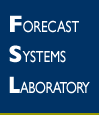![[Photo of David Skaggs Research Center]](/peth04/20041014234006im_/http://www.fsl.noaa.gov/images/IntroCol_DSRC_Front.jpg)
The David Skaggs Research Center in Boulder, Colorado, home of FSL |
The mission of the Forecast Systems Laboratory (FSL) is to anticipate the science and technology that will be needed by the nation's operational atmospheric, oceanic, and hydrologic forecasting services in the next five to ten years. After researching and developing new observing and forecasting systems, FSL transfers those technologies to operational users such as the National Weather Service (NWS), other government agencies (e.g. U.S. Air Force and the FAA), the commercial and general aviation communities, foreign weather forecasting services, and other private interests.
Dr. A.E. (Sandy) MacDonald, Director |
| The Laboratory's essential functions are:
![[bullet icon]](/peth04/20041014234006im_/http://www.fsl.noaa.gov/images/bullet.gif) Exploratory Systems Development. The rapid pace of technological change requires continuous, exploratory systems development by FSL. In cooperation with operations specialists, FSL first developed and now continuously upgrades forecasting software, called AWIPS, used by the National Weather Service. It is also helping NWS make a transition to using the Linux operating system, high speed networks, and PC technology to make forecasting even more efficient and effective. Another system under development is FX-Net, an inexpensive, scaled-down, forecast workstation system using the Internet, more easily used for training, education, fire weather, and other special applications such as the Olympic Games. Exploratory Systems Development. The rapid pace of technological change requires continuous, exploratory systems development by FSL. In cooperation with operations specialists, FSL first developed and now continuously upgrades forecasting software, called AWIPS, used by the National Weather Service. It is also helping NWS make a transition to using the Linux operating system, high speed networks, and PC technology to make forecasting even more efficient and effective. Another system under development is FX-Net, an inexpensive, scaled-down, forecast workstation system using the Internet, more easily used for training, education, fire weather, and other special applications such as the Olympic Games.
![[bullet icon]](/peth04/20041014234006im_/http://www.fsl.noaa.gov/images/bullet.gif) Research Applications. Research conducted by FSL seeks to capitalize on an improved understanding of the atmosphere-land-ocean environment to develop better techniques for observations, data assimilation, and operational forecast models. FSL operates demonstration wind profilers, is developing a new technique for recovery of water vapor using GPS, and continues to design future observing systems using balloons and automated aircraft. Data received from satellites, radar, and other operational observing systems are used in many different operational forecast models. Along with other participants, FSL is currently working on development of the Weather Research and Forecasting (WRF) model, a very high-resolution mesoscale model designed to serve both the research and operational forecasting communities. Supercomputing by FSL's massively parallel processor, named Jet, will be instrumental in developing and testing the WRF model, and also in the development of the North American Observing System (NAOS). In determining what observing systems should be part of NAOS, an extraordinary amount of computer processing is necessary to run models repeatedly with different inputs simulating the different composites of the observing system. Research Applications. Research conducted by FSL seeks to capitalize on an improved understanding of the atmosphere-land-ocean environment to develop better techniques for observations, data assimilation, and operational forecast models. FSL operates demonstration wind profilers, is developing a new technique for recovery of water vapor using GPS, and continues to design future observing systems using balloons and automated aircraft. Data received from satellites, radar, and other operational observing systems are used in many different operational forecast models. Along with other participants, FSL is currently working on development of the Weather Research and Forecasting (WRF) model, a very high-resolution mesoscale model designed to serve both the research and operational forecasting communities. Supercomputing by FSL's massively parallel processor, named Jet, will be instrumental in developing and testing the WRF model, and also in the development of the North American Observing System (NAOS). In determining what observing systems should be part of NAOS, an extraordinary amount of computer processing is necessary to run models repeatedly with different inputs simulating the different composites of the observing system.
![[bullet icon]](/peth04/20041014234006im_/http://www.fsl.noaa.gov/images/bullet.gif) System Validation. Before new technologies can be transferred to operational services, FSL uses real-time and archived data to test and evaluate new diagnostic and forecasting techniques and new hardware and software technologies. System Validation. Before new technologies can be transferred to operational services, FSL uses real-time and archived data to test and evaluate new diagnostic and forecasting techniques and new hardware and software technologies.
![[bullet icon]](/peth04/20041014234006im_/http://www.fsl.noaa.gov/images/bullet.gif) Technology Transfer. After the quality assurance process, FSL works directly with users to transfer technology improvements to operational use, as well as to users of environmental information and prediction systems. Technology Transfer. After the quality assurance process, FSL works directly with users to transfer technology improvements to operational use, as well as to users of environmental information and prediction systems. |





